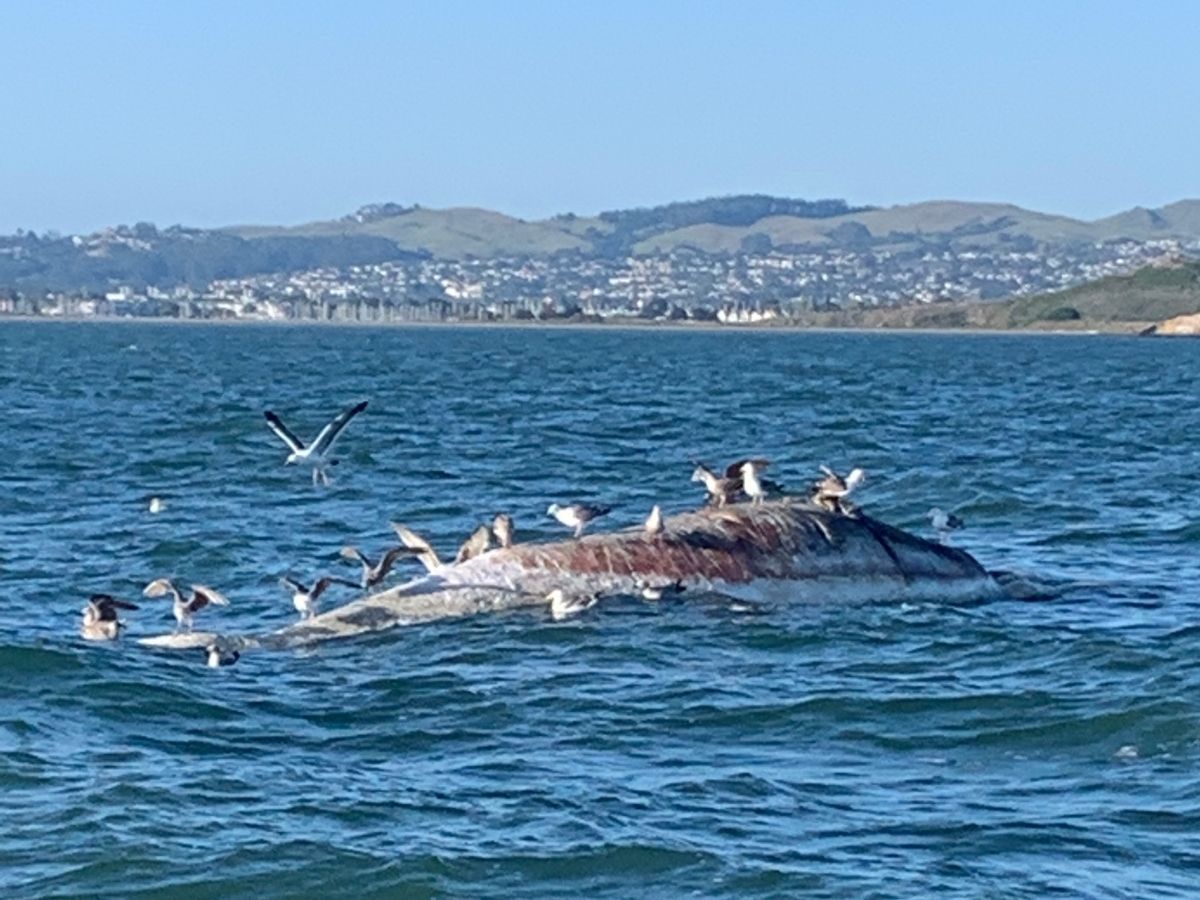
A dead gray whale once tethered in waters northwest of the Berkeley Marina broke lose in recent weeks, drifting to Richmond, where he caused quite a stink.
Literally.
Over the past couple of weeks, numerous people who crossed paths — or air wafts — with the deceased mammal that washed up on the Pt. Richmond shoreline around May 27 have complained about his pungent odor to news outlets, political and public safety officials, and social media.
The errant mammal’s landing spot, near the view-rich community of relatively new and not inexpensive houses and condos of the Brickyard Cove Waterline Development, was close to walkers, runners, bikers, and boaters.
Reports of sightings and smells reached the U.S. Army Corps of Engineers San Francisco office, which is responsible for keeping San Francisco Bay waters safe for navigation, including dealing with potentially hazardous debris, dead or alive.
The corps put the wheels in motion to deal with the offending carcass, said Nicholas E. Malasavage, Army Corps San Francisco operations chief. But he said the evaluation and planning process isn’t quick unless it’s an immediate emergency.
The Army Corps doesn’t have jurisdiction over land debris unless it’s at risk of drifting back into navigable waters. He said his office was trying to determine this risk and who else might need to weigh in on the whale’s fate. When found in Richmond, the dead whale was stuck well out of the water, he said.
Meanwhile, the beast kept decaying, and his smell ripening.
The whale’s tether, which was supposed to have kept it offshore closer to Berkeley and away from people, had clearly been cut, he said, which could have been vandalism or accident. “No way of knowing,” he said.
Malasavage sent a letter to Richmond officials Wednesday, saying the Army Corp’s recommended course of action was to leave the whale in its landing spot to finish his decomposition.
But a perturbed Richmond Mayor Tom Butt took matters into his own hands and worked with a contractor to bury the whale Thursday.
“I made arrangements to have the whale buried in situ on the beach since not a single other government agency or officials was willing to stop handwringing and step up and deal with this unfortunate whale that was stinking up the neighborhood and the Bay Trail,” Butt wrote in his June 9 e-forum, sent to thousands of subscribers.
Butt said city officials had tried unsuccessfully to find a government agency to take responsibility for the carcass.
Malasavage said the Army Corps had started “preliminary legwork with every agency that has a responsibility” for debris or large dead animals in or alongside the San Francisco Bay. It was becoming clear that by the time a plan was approved, there wouldn’t be much whale left. “By the time you align all those stars, what are you left to bury?” he said.
Because the dead whale wasn’t an immediate safety hazard to people, in or out of the water, the Army Corps concluded leaving it alone was the best course, Malasavage said. Because of its advanced state of decomposition, moving the whale at all made it tricky, he said.
“We recommended something that wasn’t a preferred outcome — let it lay,” he said.
Though Malasavage acknowledged this didn’t deal with the odor. And so, he said, he was OK with Butt’s decision to bury the whale.
“For the sake of the community, they don’t have the tremendous nuisance of the stench anymore, Malasavage said.
He added that he didn’t know if the mayor was supposed to have any permits or permissions for the burial. Butt stated he didn’t get any permits.
This whale is no stranger to the Army Corps.
First reported off Alameda in early April, the corps towed it Sausalito, a holder while decision-making, then to a spot off the Berkeley-Albany-El Cerrito shoreline, south of Brooks Island, where it was anchored to decompose naturally.
Here, the floating dead whale with gulls riding its corpse caught the attention of some Berkeley boaters.
The location, a little more than a mile offshore, was chosen for its shallow waters and distance from shipping channels and other human activity, said Capt. Kixon Meyer, who runs the corps’ ship charged with keeping bay waters clear of debris, including dead whales.
Following standard procedures, the whale was tethered with 100 feet of line plus 25 feet of chain and an anchor that will hold 40,000 pounds, said Meyer.
The anchor shouldn’t drag unless someone deliberately moves it, he said. The whale has about 125 feet in diameter of floating space, bobbing with the tides and currents.
Other than curious reports from boaters, including to Berkeleyside, the male whale didn’t cause much of a stir until late May, when he was seen, and soon smelled, in Richmond.
